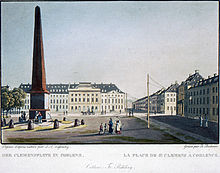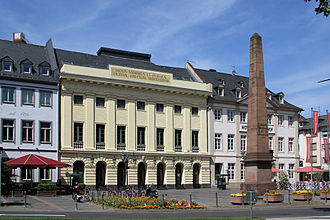Theater Koblenz
The Koblenz Theater is a multi-branch theater in Koblenz with its own ensembles for drama , music theater , puppet shows and ballet . It has around 190 permanent employees from 22 nations and offers 500 seats in a theater building from the 18th century not far from the Electoral Palace . Markus Dietze is the artistic director until the end of the 2024/2025 season. In addition to the theater on Deinhardplatz, the venues are rehearsal stages 2 and 4 and the Ehrenbreitstein fortress for the summer performances. The theater also took part in the Koblenz Festival Games for several years . In the 2009/2010 season it was renamed from "Theater der Stadt Koblenz" to its current name.
The Clemensbrunnen has stood on Deinhardplatz in front of the theater since 1970 .
history

The Koblenz Theater was built in 1787 by the architect Peter Joseph Krahe in the then new district of Neustadt on behalf of the Trier Elector and Archbishop Clemens Wenzeslaus of Saxony in a seven-month construction period . The construction management was with Johann Andreas Gärtner . Models were the Italian box theaters widespread in the 17th century, but above all the more modern French rank theaters. On November 23, 1787, the theater, designed as a multi-purpose building, was opened as the Electoral Comedy and Ballroom with a performance of Mozart's Die Entführung aus dem Serail under the direction of Johann Heinrich Böhm .
After the end of the electoral and French era, it went into private ownership, with the owners changing several times and doing little for the maintenance of the building or a demanding program. On December 16, 1851, the Koblenz opera singer Henriette Sontag appeared in the theater . It was the first and only appearance in her hometown. In 1867 the theater was bought by the city of Koblenz at an auction at the instigation of Lord Mayor Karl Heinrich Lottner . They had the dilapidated building renovated by city architect Hermann Nebel in 1869, with the interior being remodeled in the style of historicism . In 1937 and 1952 further renovations were carried out, which further modernized the appearance of the building and adapted it to the applicable safety regulations.
During the Second World War , the theater was closed in August 1944, but was able to reopen on June 1, 1946 as it was one of the few buildings in the city center that remained largely unscathed during the air raids on Koblenz . Allegedly, after an air raid in November 1944, two caretakers had diverted the fire brigade from the government building to the theater with an invented order from the Gauleiter, thus preventing the fire from being destroyed.
As the building was one of the few rooms that was not destroyed by the war and was sufficiently large, the constituent meeting of the Provincial Consultative Assembly took place in it on November 22, 1946 , which discussed the constitution of the newly founded state of Rhineland-Palatinate .
Since the theater showed considerable age damage, no longer complied with the relevant safety regulations and the stage technology was completely out of date, it was extensively restored from 1984 to 1985 with the aim of coming as close as possible to the original condition of 1787. The old dimensions of the foyer were restored and the original painting in the auditorium was reconstructed, and the facade was also given back its original color.
Since 2009, the Koblenz Theater has been organizing the impuls! V. Youth theater festival in cooperation with the Rhineland-Palatinate Cultural Office and the Rhineland-Palatinate Cultural Summer. In 2000 the theater founded the Koblenz Literature Prize together with the Institute for German Studies at the University of Koblenz and the Friends of the University .
construction
The Koblenz theater is the only preserved classical theater building on the Middle Rhine and the earliest preserved example of a rank theater in Germany (in contrast to the earlier box theater ). The exterior of the theater is characterized by a classical facade with pilasters . The rusticated ground floor is provided with arched entrances. The main and mezzanine floors above are connected by colossal pilasters. These are completed by an architrave with a triglyph frieze and a protruding cornice. On top of this is an attic with a raised central section bearing the Latin inscription "Musis Moribus Et Publicae Laetitiae Erectum MDCCLXXXVII" (The Muses, Morality and Public Delight, 1787). The gable roof is flat and strongly reduced. Today's monochrome yellow version probably corresponds to the original condition.
Inside there is a flat covered porch. The main entrances to the game room are behind a Doric column position. The central auditorium, which is held in blue, gray and white, is surrounded by a three-storey, free-floating tier arrangement that encloses the hall in a horseshoe shape. This is aligned with the former electoral lodge and decorated with illusion painting that goes back to Elmar Albrecht 1984/1985. During the restoration, this painting was created according to the architect's original plans, small remains that have been preserved indicate that it was probably also executed in this form. The stage is flanked by boxes and a fluted pair of double columns. Above the stage there is an architrave-like closure with the Latin inscription "Ridendo Corrigo Mores" (I improve morals by laughing). The flat ceiling of the hall simulates a dome through illusionistic painting and perspective distorted cassettes . There were no surviving findings for this painting, as the ceiling had been newly plastered, nor do the architect's plans show the ceiling; During the restoration in the 1980s, it was therefore recreated based on other classicist buildings. A chandelier is attached in the middle , which enhances the perspective effect.
Monument protection
The Koblenz Theater is a protected cultural monument according to the Monument Protection Act (DSchG) and entered in the list of monuments of the state of Rhineland-Palatinate . It is in Koblenz's old town at Deinhardplatz 2 .
The Koblenz Theater has been part of the Upper Middle Rhine Valley UNESCO World Heritage Site since 2002 . Furthermore, it is a protected cultural asset according to the Hague Convention and marked with the blue and white protection symbol.
literature
- Energieversorgung Mittelrhein GmbH (ed.): History of the city of Koblenz . Overall editing: Ingrid Bátori in conjunction with Dieter Kerber and Hans Josef Schmidt
- Vol. 1: From the beginning to the end of the electoral era . Theiss, Stuttgart 1992. ISBN 3-8062-0876-X .
- Vol. 2: From the French city to the present . Theiss, Stuttgart 1993. ISBN 3-8062-1036-5 .
- Cultural monuments in Rhineland-Palatinate Volume 3.2. City of Koblenz. Downtown. edited by Herbert Dellwing and Reinhard Kallenbach , Speyer 2004, p. 114f. ISBN 3-88462-198-X .
- Johann Maeckler: Origin of the theater and outline over its time. January 16, 1869, in StAK 623 No. 2415, pp. 14–41 [= First Koblenz Theater Chronicle]
- C. Dommershausen: The city theater in Coblenz. A commemorative publication for the 100th anniversary. Coblenz 1887.
- Fritz Michel : The art monuments of the city of Koblenz. The mundane monuments and the suburbs. Munich Berlin 1954, (The art monuments of Rhineland-Palatinate first volume).
- Reinhard Dorn : Peter Joseph Krahe. Volume II, Buildings and Projects in Düsseldorf, Koblenz, Hanover and Braunschweig, 1787–1806. Braunschweig 1971.
- Karl Oster (editor): Theater of the City of Koblenz. General overhaul 1984/85. (Documentation by the City of Koblenz, 11) Koblenz 1985.
- Magnus Backes : The Theater in Koblenz . (= Rheinische Kunststätten; issue 307). Neusser Druckerei und Verlag, Neuss 1986, ISBN 3-88094-542-X .
- Fritz Bockius 200 years of the Koblenz Theater 1787–1987. Koblenz 1987 (Koblenz contributions to history and culture)
- Petra Habrock-Henrich: Exhibition 200 Years of Theater Koblenz. List of exhibits (showcase 5), Koblenz 1987 (StAK 623, No. 2415)
Web links
- Official website of the Koblenz Theater
- Theater Koblenz in: regionalgeschichte.net
Individual evidence
- ↑ Markus Dietze: Koblenz director until 2021 in: Rhein-Zeitung , November 4, 2014
- ↑ Markus Dietze until 2025 artistic director in Koblenz , nachtkritik.de of January 11, 2019, accessed January 16, 2019
- ^ The CATS is back on a permanent stage in: musical1.de
- ^ December 16, 1851. The singer Henriette Sontag's only appearance in Koblenz. In: Landesgeschichte . State Archives Administration Rhineland-Palatinate, accessed on September 5, 2019 .
- ^ General Directorate for Cultural Heritage Rhineland-Palatinate (ed.): Informational directory of cultural monuments - district-free city of Koblenz. Mainz 2020, p. 6 (PDF; 6.5 MB).
Coordinates: 50 ° 21 ′ 29.4 " N , 7 ° 35 ′ 58" E
